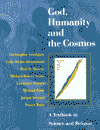God of the GapsThere was a long period in Western thought in which God seemed to be progressively edged out of descriptions of the development and functioning of the world - both as described by physics and by biology. We summarised this period briefly in the love affair gone wrong. In
particular it was seen how difficult it was to sustain descriptions of the
physical world in which God acted as a cause complementing physical causes -
filling in a gap left by scientific narratives. The
phrase ‘God of the gaps’, coined by C.A.Coulson, The reason is simply that as science advances, so the causal ‘gap’ often seems to disappear. A few examples should make this clear:
Three strategies seem to offer themselves in the face of this problem: God ‘banished’, God ‘before’, or God ‘behind’.
In the light of these ‘safe’ strategies, which are all forms of ‘separate development’ for scientific and theological description, it is striking how many recent theologians have wanted to pursue a fourth path - they have regarded the system of causation that physics offers us as open, containing inherent gaps which allow God to effect particular actions within the system of natural causes without being subject to the risk that science will close the gaps. This strategy has a great deal to do with
the contemporary perception that what happens in the real universe is the
result of the interplay of physical laws and an ingredient of chance. We do not live in the deterministic universe of Laplace (see Determinism,
indeterminism and their implications), but in one in which it is not even
theoretically possible to predict in minute detail what will happen next. In order to proceed with our investigation of divine action we must first set down a) what might be the relationship between physical law and divine action and b) exactly what might be meant by ‘chance’. See law and chance.
Email
link | Feedback | Contributed by: Dr.
Christopher Southgate |




